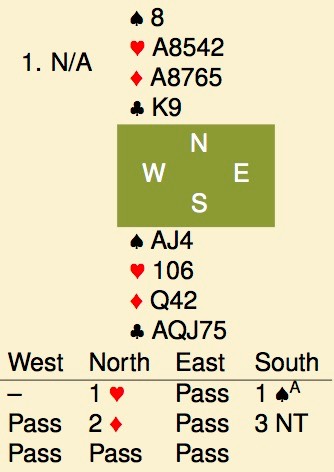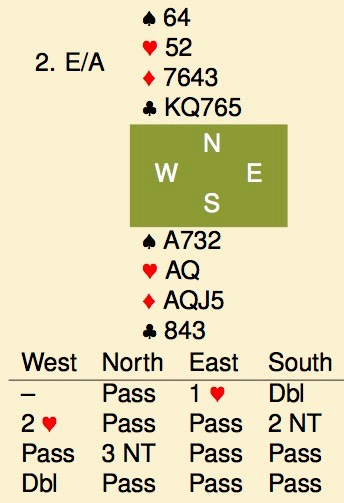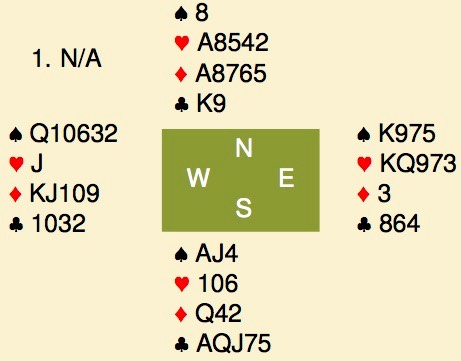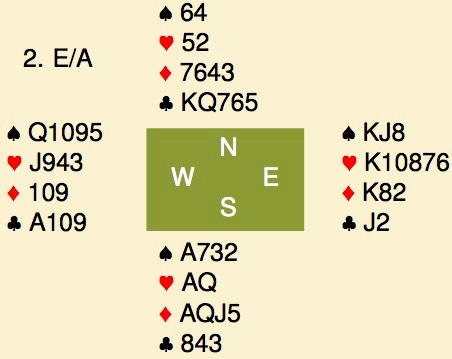
Let’s start with 2 play problems.
On the first hand, 1♠ showed 0-4 spades and was obviously forcing. Everything else natural. West leads the ♠2, 3rd and 5th, to the ♠8 and ♠K. Plan the play.

On the second one: ♥3 lead, this time 4th best, to the ♥K and ♥A. You start on clubs in trick 2: ♣3, ♣9, you play the ♣K and east drops the ♣J. Plan the play.

The year started with the first edition “A New Bridge Magazine” (www.newbridgemag.com) which is, as you may have guessed, a new magazine on the game. The new magazine is a successor to the British “Bridge Magazine”. “Bridge Magazine” was founded in 1926 but had to shut down late 2017 due to increasing production costs and a lack of subscribers. I have to admit that I did let my subscription lapse too. Why? Mainly for the lack of interesting content, but more about that later.
The new magazine is run by the same editor (Mark Horton) and pretty much the same crew that filled the pages of the old magazine. Somewhat surprisingly, the new magazine is free, it can be read online or you can download a pdf. Printed issues are not available, if you want that you have to print it yourself. Now, a magazine is not free to produce, so where does the money come from? Mark Horton explains this in the editorial: sponsorship and ads.
Fine, but this shows also a flaw in the business model. For the magazine to break even, it needs 50,000 (!) readers each month. That is a lot, considering that the total membership of all NCBO’s (National Contract Bridge Organization, or the organization that runs the game in a country, like the NBB, ACBL or EBU) worldwide is only some 700,000. That means that 1 in about 14 players worldwide has to start downloading the magazine every month. That is a lot, considering that not all 700,000 have Internet access, have the language skills to read a magazine in English, and consider themselves the intermediate or advanced player that magazine aims at.
And if one looks at the UK only, the 3 NCBO’s there have a combined membership of about 45,000, so everybody has to download a copy to get close to the 50,000. Again, this is a lot, in fact, it reminds me of expected usage numbers quoted by content providers in the first days of the Internet bubble. We all know what happened here: a few years later, the numbers turned out to be overly optimistic and the bubble burst.
Still, if the content warrants it, you might get your downloads. However, here I was disappointed too. First the practical side: magazine aims to be read online but is in fact a pdf shown in your browser. The default font is quite small, you can zoom but then when you turn the page, that setting is undone again. Downloading and printing doesn’t help either, pages are landscape and don’t print very well. Finally, there is no interactivity on the pages. There are some URL’s in the text, but clicking them doesn’t do anything. Sorry, but have we gone back to the 1980’s before HTML was invented?
And then the contents: the magazine starts off with a 31 page report on the Madeira tournament. While I hear that it was a nice event, it is hardly the highlight of the bridge calendar of the year. Now, the editor of the magazine was hired to produce the daily bulletin of the tournament. Those bulletins are online, and it looks like he simply did a cut and paste of the bulletins into the magazine. He could have written “this was a nice tournament, click here if you want to see some hands”. Note that this isn’t new, it also happened in the old Bridge Magazine (and that is one thing I didn’t like about it).

Problem #1 is from this event. You are in 3NT and west leads the ♠2 to the ♠8 and ♠K. Your play?
You have 8 tricks and have to set up a 9th. Only diamonds offer some chance of doing so by cashing the ♦A and playing a diamond to the ♦Q. If you have ducked the spades twice and east has the ♠K and only 3 spades, you have your contract. Right?
Wrong! The ♠2 lead (and the lack of an overcall) suggests that the spade suit breaks 5-4 (with west holding ♠Qxxxx and east ♠Kxxx) so this plan won’t work. What you have to realize is that the spade suit still hasn’t been set up for the opponents. West has the ♠Q (with ♠KQ, east would have played the ♠Q in trick 1) and if west gains the lead before east has led a second round of spades, he cannot cash them. And when can east lead a second round of spades? At trick 2 if you duck the first trick! To prevent that, win the first trick with the ♠A. Now all you have to do, is to strip west from his exit cards.
5 rounds of clubs, both sides follow 3 times, west discarding a diamond and a heart, east discarding 2 hearts. Now the ♦A and a diamond. East shows out but you are in full control. West wins the ♦Q with the ♦K and eventually has to play away from the ♠Q10 setting up the 9th trick.
It is a pairs contents and this scored 71%. Fine, but if this is intended as instructive, then showing percentages for other results would have been useful.
Anyway, if you survived the 31 pages on the Madeira tournament, I’m afraid it doesn’t get much better. 2 articles on Muppet or Puppet Stayman? A discussion of bidding by leading pairs full of statements “it looks like 4♥ showed Y”, “I believe this show Z”, etc. All top players have email these days, so why not ask and check rather than guess?
And finally, an episode of the monks at St.Titus. That series has been around for more than 30 years and it shows. The characters have not evolved much, with brother Damian still looking in his thirties while he must be close to 60 by now, and the plot is predictable. Also, it is hard to find interesting hands for 30 years. Problem 2 is an example.
NS had some issues about the range shown by 2NT and the final contract is quite high. However, things improved after 2 tricks. ♥3 lead, 4th best, to the ♥K and ♥A. You start on clubs in trick 2: ♣3, ♣9, ♣K and east drops the ♣J. Now what?

West obviously has the ♣A, so to set up that suit you will have to lead clubs from hand again. But, for east to have his opening bid, he must have the ♦K, so at trick 3, take a diamond finesse. It wins as expected. Play a second round of clubs. West does best to duck and declarer takes a second diamond finesse. A third round of clubs is led and west wins his ace. However, declarer is now in full control: ♦A drops the ♦K, and the ♦5 can be overtaken with the ♦7 as an entry for the long clubs.
OK, this is something you have to think about for a few seconds but the theme (develop 2 suits at the same time) has been seen before and is hardly worth mentioning in a magazine aimed at advanced players. The rest of the story isn’t that exciting: 3NT now made 11 tricks, for -1150. You can guess the rest of the story: the other table is in 3♥ by east, down 1, so this is 15 away and the abbot loses the match by 1. The abbot blames his teammates for not bidding their cold game, his partner for doubling and for not leading a spade. Either action would indeed have saved the match, but the real issue is of course the sub-standard opening bid from the abbot.
It is nice to see a new publication, but if this is the content, I seriously doubt that they’ll have (and keep) their 50,000 monthly downloads anytime soon.
